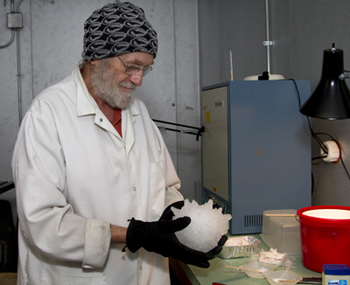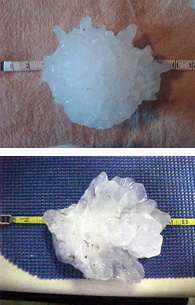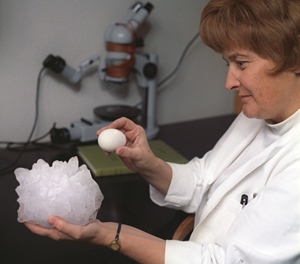All hail
A giant stone in South Dakota pummels U.S. record
Nov 2, 2010 - by Staff
The NSF NCAR Mesa Lab will be closed Thursday, Dec. 18, and Friday, Dec. 19, due to extreme winds and power outages.
View more information.Nov 2, 2010 - by Staff
2 November 2010 • There was no gold medal, no podium ceremony, and definitely no tears from the losers on 30 July, but there was a new national champion. On that date, NOAA proclaimed that a South Dakota hailstone had surpassed all contenders in both size and weight. Officially a hefty 31 ounces and almost 19 inches in circumference, the stone fell in the yard of Les Scott of Vivian, South Dakota, on 23 July.

Charles Knight prepares to make a three-dimensional model of the Vivian hailstone. (©UCAR. Photo by Carlye Calvin.)
Scott, who collected it and reported it to the National Weather Service, said, “If I knew it might be a record, I would have looked for a bigger one. There [were] lots bigger ones than the one I got.” According to Scott, the record stone itself was bigger when he first popped it into his freezer, but it melted a bit during a power outage.
The hailstone even had a victory lap of sorts: a four-state, triumphal procession from the NWS office in Aberdeen, South Dakota, to NCAR in Boulder, where it will be immortalized in a three-dimensional plaster cast. “They could have FedExed it in dry ice,” admits Henry Reges (Colorado State University), national coordinator for the Community Collaborative Rain, Hail & Snow Network. “But I guess we just wanted to make sure nothing happened to the stone. Also, this was a once-in-a-lifetime opportunity, kind of like being part of the Pony Express.” Reges was in charge of the trip’s last leg, from Cheyenne, Wyoming, to Boulder; NWS staffer Dave Hintz took it from Aberdeen to Valentine, Nebraska, and Steve Apfel (also NWS) from there to Cheyenne.
To certify a U.S. hailstone record, the National Climate Extremes Committee takes four criteria into consideration.
First, they make sure that the item is indeed a hailstone rather than, say, a chunk of ice fallen from a plane.
Second, they verify its dimensions—in the Vivian case, from the meticulous documentation provided by the Aberdeen NWS office, which even calibrated the scale at the local post office where the stone was initially weighed.
The third step is to ascertain that the weather conditions that day could have produced such big hail, ruling out the possibility that the stone fell somewhere else or at a different time.
Finally, Arndt and his fellow committee members Kelly Redmond (Desert Research Institute) and James Zdrojewski (NWS) check the existing record against the stats of the new contender. In the Vivian case, the contest was a walkover. In fact, Arndt notes, if the committee were in the business of awarding additional rankings besides first place, another stone from the same storm would probably have knocked the Aurora hailstone down to a bronze medal.
For the last few years, the U.S. championship has been split between heaviest and largest hailstones. A 1.67-pound behemoth that fell in Coffeyville, Kansas, held the heavyweight title for 40 years, but it gave up the record for size to a stone that fell in Aurora, Nebraska, in 2003. Before the Coffeyville hailstone, one that fell in Potter, Nebraska, in 1928 held both titles at 1.5 pounds and 17 inches in circumference. (See box for a full comparison.)
The arbiter of U.S. weather records—high and low temperatures, snowfall, etc., as well as hail—is NOAA’s National Climate Extremes Committee, chaired by Deke Arndt of the National Climatic Data Center. To claim the title, the Aberdeen NWS office reported the stone to Arndt. “Because the office documented the case so well, it was a very easy decision,” he says.
The making of a champion
What does it take to grow a world-record hailstone? “A lot of supercooled water and a lot of updraft; that’s about it,” says Charles Knight. An NCAR scientist since 1962, Knight is a highly respected—and still very active—expert on hail and supercooled water. As part of their decades of work on the topic, Charles and Nancy Knight studied the Coffeyville and Aurora record-holders in detail. Knight is making the cast of the Vivian stone.
Hail begins to form when a tiny piece of ice within a cloud is blown into a supercooled water droplet, which remains liquid at temperatures below freezing as long as it lacks a nucleus. The nascent hailstone continues to grow by collecting and freezing more supercooled cloud droplets while being carried up into colder parts of the cloud. Storm clouds are turbulent, so a growing stone can rise and fall irregularly, accumulating layers more or less randomly, Knight explains. As layer forms atop layer, the hailstone eventually becomes too heavy to stay airborne and falls to the ground. A supercell thunderstorm can pack updrafts as strong as hurricane winds, which allows some hailstones to grow to mammoth sizes.
The principles of hail formation have been understood for more than 50 years, Knight says, and currently there’s little or no research that focuses solely on that process. Thunderstorm studies, however, continue to provide new data on hail, and limited hail data are also collected in countries with weather modification programs.
Big hail and its consequences
The world-record hailstone, which weighed in at a terrifying 2.25 pounds (1.02 kilograms), fell in Bangladesh during a 14 April 1986 hailstorm that killed 92 people. No one would want to see that kind of devastation, but it’s not unthinkable that the U.S. could break the record someday, according to Harold Brooks (National Severe Storms Laboratory). Brooks points out that, in this country, we have both a strong tradition of weather observing and a history of unusually large hail.
Brooks explains that the strong updrafts needed for big hail can be fostered by a tall mountain range, which creates turbulence downwind in the same way that large boulders in a river cause rapids. Other aids include a high ground elevation, which means that the uppermost reaches of thunderstorms will be colder, and a convenient source of moisture. The U.S. High Plains have all of these characteristics: the wide and tall Rocky Mountains upwind, surface elevations of 3,000 to 5,000 feet, and the Gulf of Mexico not far away. The juxtaposition often makes for a strong contrast between cold air aloft and warm, moist air below. “Lapse rates over the Rockies are unique on the planet,” Brooks says, referring to the rate of temperature change with height. High lapse rates feed instability and therefore can increase updraft velocity.
The bizarre shapes of the Vivian, Aurora, and Coffeyville hailstones (see photos below) are a far cry from the symmetrical pea-sized and golf-ball-sized hail that’s all too familiar to Midwesterners. The irregularities hint at just how much supercooled water was in their parent clouds, according to Charles Knight. “I think the bumps form very much the same way that icicles form. The hailstone is collecting more water than it can freeze, and that water flows over the outside of the stone and sheds off the top side as it falls. But it’s quite complicated.”
To Knight, one of the most interesting things is that the bumps are not equally distributed across the entire surface area. “There’s certainly a suggestion that there is a top side, presumably the side with the bumps, that would have formed like icicles except projecting upward, that is, downwind from the perspective of the hailstone. It appears that the Vivian hailstone, much like the Aurora and Coffeyville ones, has a thick outside layer that grew low in the storm in a very strong updraft at a relatively warm, subzero temperature.”
Although hail deaths in this country are rare, U.S. hailstorms each year cause an estimated $1.3 billion in crop damage (1–2% of annual crop value) and possibly as much as another $1 billion in property damage. In western Nebraska and Kansas—the homes of three of the four champion stones—and eastern Colorado, the crop damage from hail runs as high as 5–6% of value. While the biggest stones easily smash windows and windshields, some of the worst crop damage occurs from dense, windblown swaths of smaller hail.
What a hailstone can, and can't, tell us
The South Dakota hailstorm drew on unusually high amounts of moisture throughout the depth of the atmosphere. That was a consistent feature of the steamy weather across much of the United States in the summer of 2010, and enhanced atmospheric water vapor is a predicted outgrowth of global warming. But Knight and Brooks agree that the discovery of two record hailstones within a single decade can’t be directly linked to climate change. As Knight says, “If global warming does lead to more severe storms, as some claim, then other things being equal, that would imply more and perhaps larger hail—but other things are never equal.” According to Brooks, there is at least some evidence from recent studies done in Europe (which are still in review) that the size of hailstones has gotten slightly larger there. However, he notes, “the Europeans don’t get hail that’s larger than a couple of inches anyway, and the difference falls within the error range. Also, it’s not clear that if the increase does exist, it extends to the really big stuff.” He thinks that it’s more likely that the improved observing network is simply detecting hailstones better.
They may not be bellwethers of climate change, but gigantic hailstones do give information about the storms they grow in, says Knight. “Larger hailstones tumble, so their growth shape reflects the tumbling motion. The nature of the growth layers—their air bubble content and crystalline structure—indicates roughly the temperature, or height, and cloud water content during growth. A lack of air bubbles indicates warm and wet growth, with liquid water flowing over the hailstone.”
Knight had hoped to cross-section the Vivian hailstone to glean more of this kind of understanding. But the man who found the stone asked Knight to return it intact, as he’s hoping to give the chunk of ice another distinction: the first world-record hailstone to be sold on eBay.
—Carol Rasmussen

Record-smashing hailstones from Vivian, SD (top) and Aurora, NE (bottom). (Photos courtesy NWS.)
Vivian, South Dakota
23 July 2010
Weight: 1 lb, 15 oz (878.8 g)
Diameter: 8” (20.3 cm)
Circumference: 18.6” (47.3 cm)
Aurora, Nebraska
22 June 2003
Full weight: could not be obtained because the stone broke during handling
Diameter: 7” (17.8 cm)
Circumference: 18.75” (47.6 cm)
Coffeyville, Kansas
3 September 1970 (see photo below)
Weight: 1 lb, 11 oz (765 g)
Diameter: 5.7” (14.5 cm)
Circumference: 17.5” (44.5 cm)
Potter, Nebraska
12 July 1928
Weight: about 1 lb, 8 oz (680 g)
Diameter: 5.4” (13.7 cm)
Circumference: not reported

NCAR researcher Nancy Knight examines the Coffeyville hailstone in this 1970 photo. (©UCAR.)